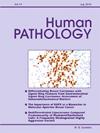Genetic alteration analysis of non-pediatric diffuse midline glioma, H3 K27-altered
IF 2.7
2区 医学
Q2 PATHOLOGY
引用次数: 0
Abstract
Diffuse midline gliomas with H3 K27-alteration (DMGH3) are lethal and inoperable brain tumors. Although DMGH3s mainly occur in pediatric patients, they have also occurred in adult patients. This study aimed to analyze the clinicopathological significance of targetable genetic alterations in non-pediatric DMGH3. Next-generation sequencing (NGS) was conducted on 18 non-pediatric DMGH3 patients to analyze additional genetic alterations. The median age at diagnosis was 35 years, and the mean follow-up duration was 762 days. Fourteen cases involved the thalamus-hypothalamus (77.8%). Histologic high-grade features (WHO histologic grade ≥ 3) were observed in 11 (61.1%) patients. H3F3A (H3 K27 M) alterations were identified in all 18 patients using immunohistochemistry and NGS. TP53 mutations were found in 11 patients (61.1%), FGFR1 or PIK3CA in 3 (16.7%), ATRX in 6 (33.3%), NF1 in 4 (22.2%), and KRAS or ATM in 1 (5.6%). TP53 mutations were significantly correlated with high-grade histological features and worse overall survival (OS) (P < 0.05). Despite non-pediatric DMGH3 cases exhibiting superior OS compared to pediatric DMGH3 cases, TP53 mutations were associated with poorer OS outcomes. Notably, FGFR1 and PIK3CA mutations, which have been identified as potential targetable genes, were detected. In conclusion, non-pediatric DMGH3s showed predominant tumor localization within the thalamus and improved prognosis compared to those in pediatric cases, with TP53 alterations correlating with high-grade histology and shorter survival. Genetic profiling, particularly identifying targetable mutations like FGFR1 and PIK3CA, could inform personalized treatment strategies and improve patient outcomes.
非儿童弥漫性中线胶质瘤H3 k27基因改变分析。
弥漫性中线胶质瘤伴H3 k27改变(DMGH3)是致死性且不能手术的脑肿瘤。虽然DMGH3s主要发生在儿科患者中,但在成人患者中也有发生。本研究旨在分析非儿童DMGH3中可靶向基因改变的临床病理意义。对18名非儿童DMGH3患者进行了新一代测序(NGS),以分析其他遗传改变。确诊时的中位年龄为35岁,平均随访时间为762天。14例累及丘脑-下丘脑(77.8%)。11例(61.1%)患者出现组织学高级别特征(WHO组织学分级≥3)。在所有18例患者中,通过免疫组织化学和NGS检测到H3F3A (H3 K27M)的改变。TP53突变11例(61.1%),FGFR1或PIK3CA 3例(16.7%),ATRX 6例(33.3%),NF1 4例(22.2%),KRAS或ATM 1例(5.6%)。TP53突变与高级别组织学特征和较差的总生存期(OS)显著相关(P < 0.05)。尽管非儿童DMGH3病例比儿童DMGH3病例表现出更好的OS,但TP53突变与较差的OS结果相关。值得注意的是,FGFR1和PIK3CA突变被发现是潜在的靶向基因。总之,与儿童病例相比,非儿童DMGH3s表现出主要的肿瘤定位在丘脑内,预后更好,TP53改变与高级别组织学和较短的生存期相关。基因分析,特别是识别靶突变,如FGFR1和PIK3CA,可以为个性化治疗策略提供信息并改善患者预后。
本文章由计算机程序翻译,如有差异,请以英文原文为准。
求助全文
约1分钟内获得全文
求助全文
来源期刊

Human pathology
医学-病理学
CiteScore
5.30
自引率
6.10%
发文量
206
审稿时长
21 days
期刊介绍:
Human Pathology is designed to bring information of clinicopathologic significance to human disease to the laboratory and clinical physician. It presents information drawn from morphologic and clinical laboratory studies with direct relevance to the understanding of human diseases. Papers published concern morphologic and clinicopathologic observations, reviews of diseases, analyses of problems in pathology, significant collections of case material and advances in concepts or techniques of value in the analysis and diagnosis of disease. Theoretical and experimental pathology and molecular biology pertinent to human disease are included. This critical journal is well illustrated with exceptional reproductions of photomicrographs and microscopic anatomy.
 求助内容:
求助内容: 应助结果提醒方式:
应助结果提醒方式:


